Issue 3 2018
Table of Contents
- From the Director
- Conference builds links between industry and research
- Three Minute Thesis (3MT)
- Lentils rise to the challenge of making healthier bread
- Valuable global perspective at IRRI
- Getting a taste for baijiu in China
- FGC engagement
- New PhD student- Debra Metcalf
- In search of a winter wonderland
From the Director
It’s been an exciting few months for Functional Grains Centre staff and students.
Congratulations to PhD student Michelle Toutounji who represented Charles Sturt in the Asia Pacific Finals of the Three Minute Thesis and well done to all our students, Nancy Saji, Annie Riaz, Esther Callcott, Shiwangni Rao and Stephen Cork who took part in the CSU event.
 I’m always proud to see our students engaging with the community, a good example is their participation in the Graham Centre for Agricultural Innovation’s Science and Agriculture Enrichment day. The event gives high school students a taste of science in action and it was great to see FGC students explaining how our research is developing new processes and products to benefit the entire grains value chain.
I’m always proud to see our students engaging with the community, a good example is their participation in the Graham Centre for Agricultural Innovation’s Science and Agriculture Enrichment day. The event gives high school students a taste of science in action and it was great to see FGC students explaining how our research is developing new processes and products to benefit the entire grains value chain.
Sean and I travelled to China to visit Zhong Kai Zhou and his colleagues at Tianjin University of Science and Technology to establish a collaboration to work on our baijiu project. We managed to survive the obligatory baijiu testing and established some excellent collaborations.
Several FGC students have had the opportunity to participate in a number of workshops and conferences including the Innovation Generation conference and a Graham Centre sponsored workshop on presentation skills. Our students used the skills gained in this workshop at the Australasian Grain Science Association Conference held at Charles Sturt and supported by the FGC. Students and postdocs all worked hard at the conference by both presenting and chairing sessions. Rachael received the best student poster prize award and Esther again received an award for her excellent oral presentation.
In other good news, Rachael, Nancy, Michelle, Esther and Shiwangni have all received top-up scholarships from Agrifutures Australia. These top-ups will ensure the students will have the ability to complete their projects and produce high quality research outputs.
Finally I would like to congratulate PhD candidate Kyah Hester for being the first Australian Research Council (ARC) funded FGC student to submit their thesis for examination. I’m sure the examiners will like what they see!
Regards,
Chris
Photo caption: Dr Asgar Farahnaky and Professor Chris Blanchard, co-hosts of the 2018 AGSA conference. Read more about the conference here.
Conference builds links between industry and research
Building links between researchers, industry and funding bodies is being hailed as one of the highlights of the 68th Australasian Grain Science Association Conference.
The conference was held at Charles Sturt University in September and the Functional Grains Centre was pleased to be a supporter of the event.
Conference Co-Chair, FGC Director Chris Blanchard said, “The conference was well attended with more than 100 researchers, students and grains industry representatives taking the opportunity to hear about scientific advances ro improve the profitability of the grains value chain.
“I believe one of the key outcomes was the interaction between researchers, the industry and the funding organisations.
“It’s important for the industry to set the research agenda so that projects are targeted at solving real world problems and the outcomes will be adopted by producers and new technological advances commercialised by the industry.
“It was great to have presentations from SunRice, the Grains Research and Development Corporation, AgriFutures pulse exporter AGT Foods and canola porcessor MSM Milling.”
The three-day conference included more than 100 presentations and posters showcasing research to improve plant breeding, develop new products and processing techniques, and to better understand nutrition and human health.
FGC PhD student Ms Rachael Wood was awarded best student poster presentation and Ms Esther Callcott won the best student oral presentation, awarded jointly with Mr Nigarin Sultana of Murdoch University.
“Members of the Functional Grains Centre played an important role in helping to organise and run this conference and should be proud of their contribution,” Professor Blanchard said.
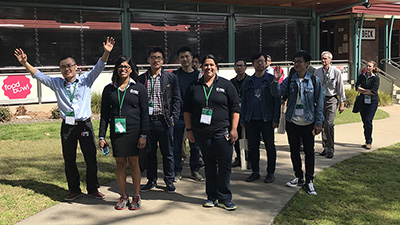 | 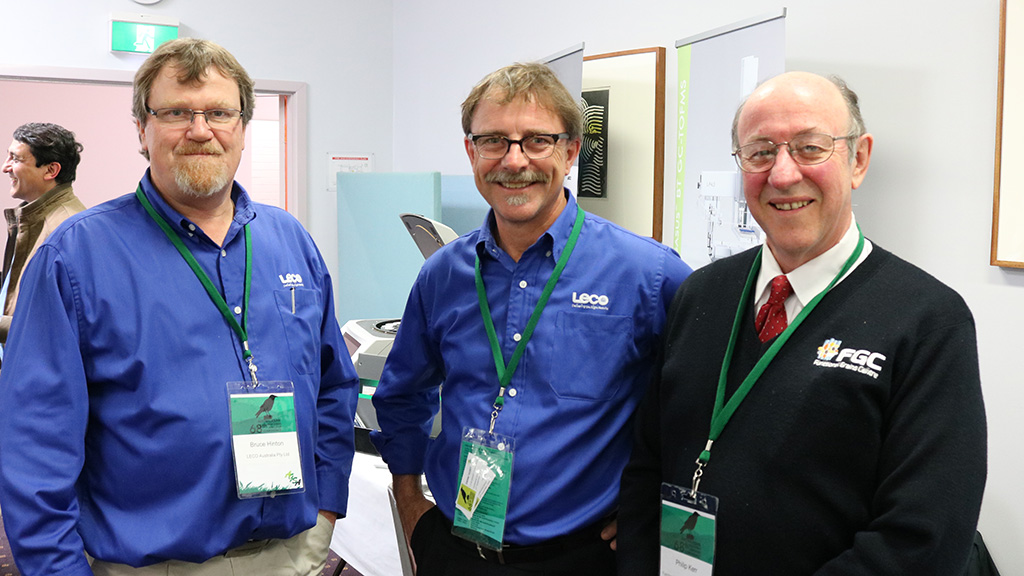 | 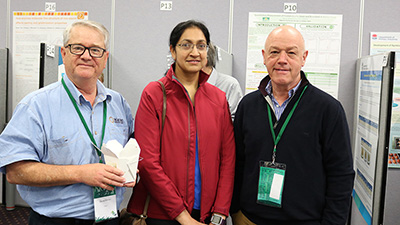 |
 |  | 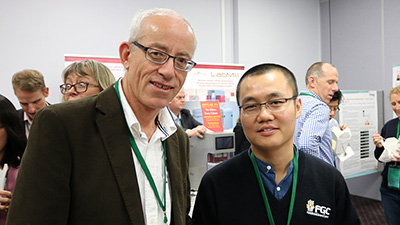 |
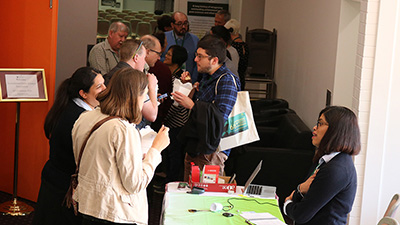 |  |  |
Three Minute Thesis (3MT)
Functional Grains Centre PhD student Michelle Toutounji has competed in the Asia Pacific Final of the Three Minute Thesis 3MT competition, presenting her research on low GI rice.
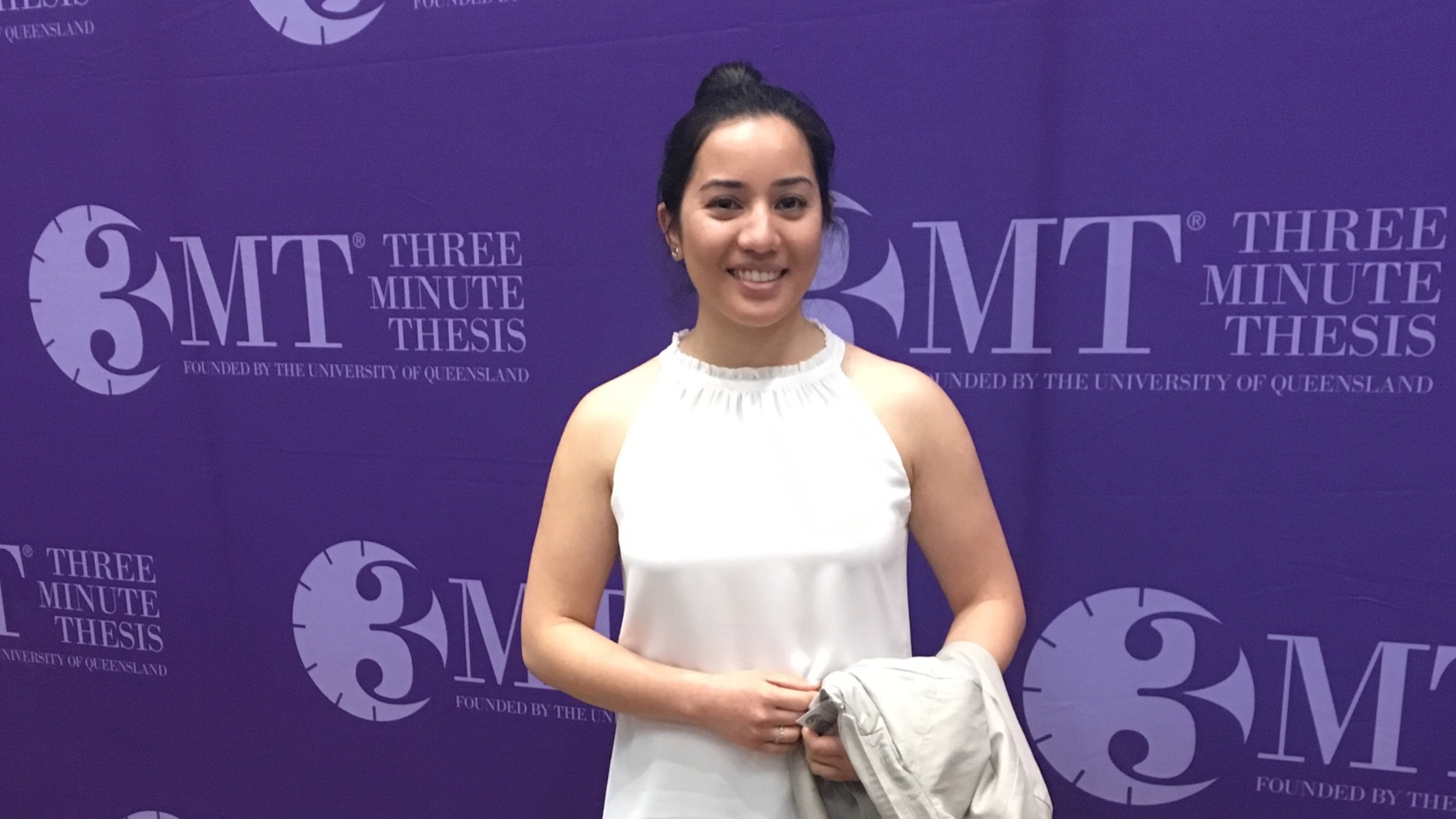
Competitors must explain their research in three minutes, in a language appropriate to a non-specialist audience and they are allowed only one PowerPoint slide.
Michelle earned her spot after taking out the Charles Sturt University final in July. Her presentation ‘White Rice: Naughty or Nice?’ explains research to alter the starch structure in white rice, using heat and pressure treatments, to produce a diabetic friendly product.
FGC students shone at the Charles Sturt final, accounting for half the finalists.
FGC Deputy Director Associate Professor Dan Waters said, “All students engaged in the 3MT challenge relished, delivering excellent and engaging talks which entertained the audience.”
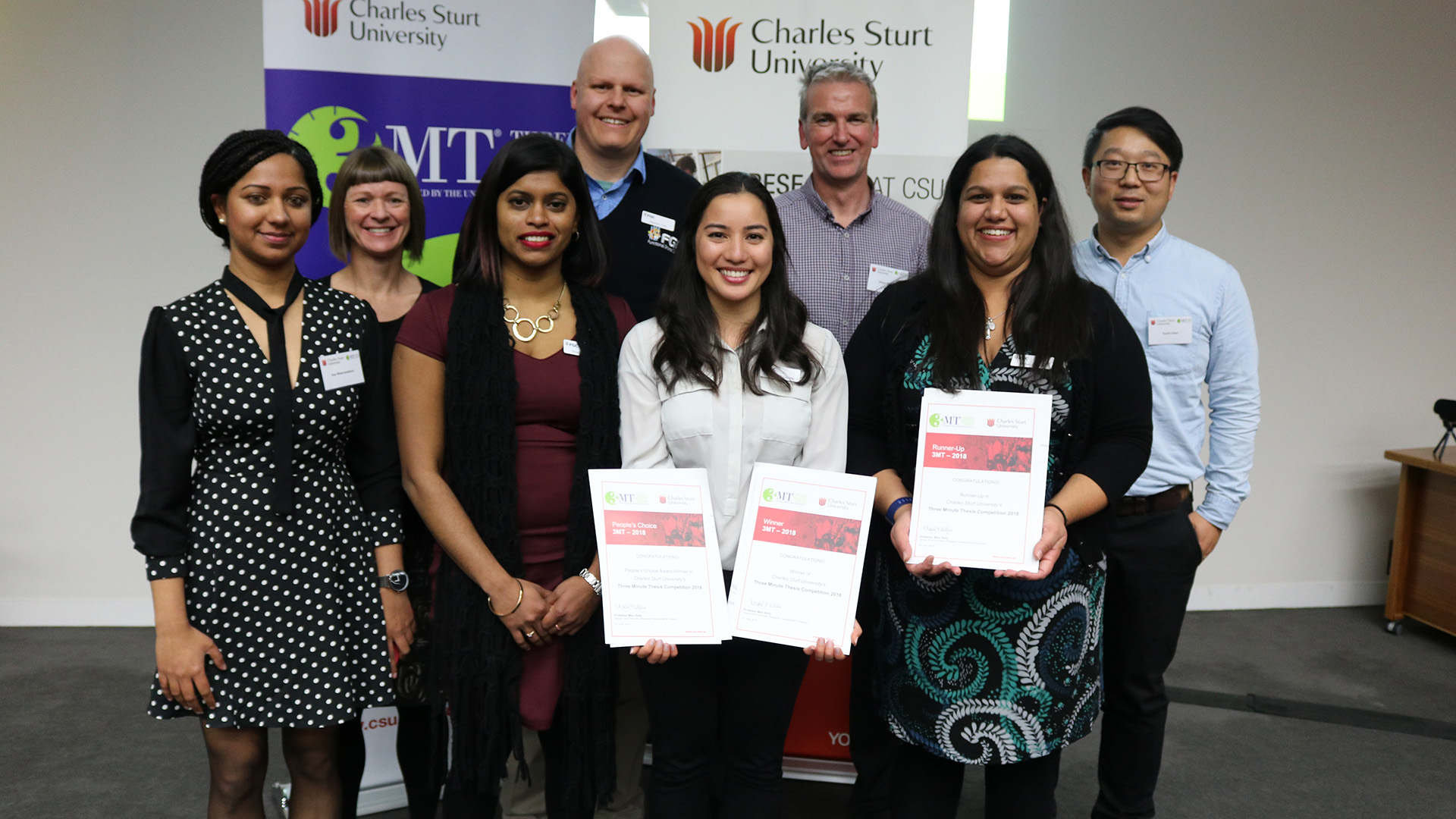 Shiwangni Rao and Esther Callcott spoke about their work which has shown how coloured grains improve markers of human health while Stephen Cork explained how new chickpea flakes will expand the healthy options in the convenience breakfast food market.
Shiwangni Rao and Esther Callcott spoke about their work which has shown how coloured grains improve markers of human health while Stephen Cork explained how new chickpea flakes will expand the healthy options in the convenience breakfast food market.
“Although each individual conceived and constructed their own talk, FGC students worked as a team, practicing their presentations together and providing tips and advice on how each presentation could be improved,” Professor Waters said.
“Along with claiming the Charles Sturt University 3MT title Michelle also picked up the People’s Choice Award. Esther was awarded runner-up completing a FGC clean sweep of the prizes on offer and confirming the value of the great teamwork our students bring to all they do”.
Photo caption: Michelle at the Asia Pacific Finals in Brisbane
Photo caption: The finalists at the Charles Sturt 3MT
Lentils rise to the challenge of making healthier bread
There’s nothing quite like the smell of freshly baked bread but in his research Functional Grains Centre PhD candidate Drew Portman is also considering the volume of the loaf, crumb structure and nutritional properties.
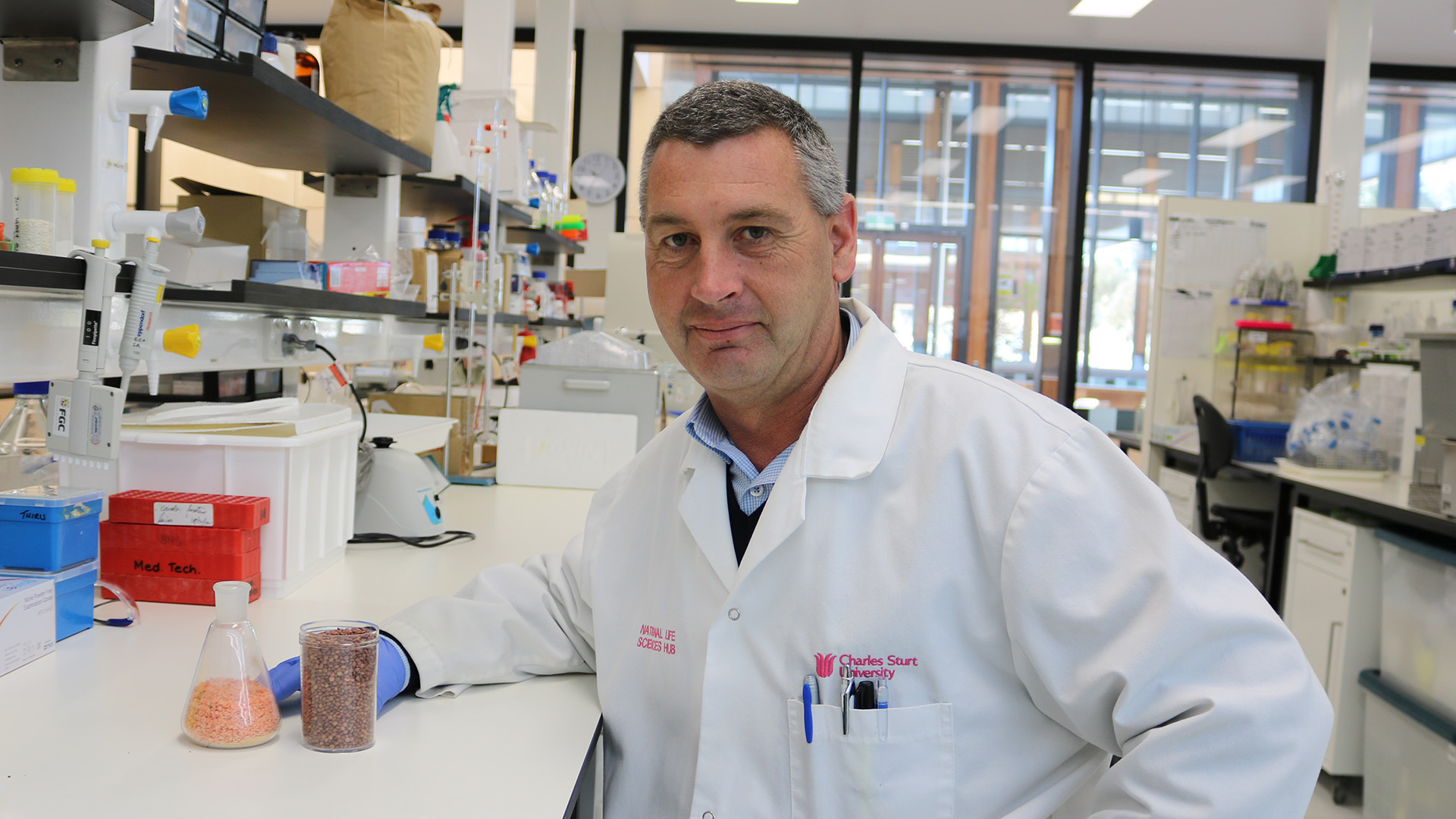 Mr Portman’s research being carried out with Agriculture Victoria is investigating how lentil flour can be incorporated into wheat-based foods, such as bread, pasta or snacks.
Mr Portman’s research being carried out with Agriculture Victoria is investigating how lentil flour can be incorporated into wheat-based foods, such as bread, pasta or snacks.
“Lentils are widely consumed within Indian subcontinent and that’s where the bulk of the product grown in Australia is exported,” Mr Portman said.
“Although lentils are gaining popularity as a food source in western diets, wheat is the staple grain used for manufacturing food products.
“That means many of us are missing out on the nutritional benefits of lentils as they’re a great source of protein and the essential amino acids.”
The research at the Agriculture Victoria Grains Innovation Park, in Horsham involves testing the rheological and baking properties such as loaf volume and crumb structure but also examining the nutritional and chemical properties for potential health benefits of the final product.
“My research so far has shown that blending lentil and wheat flour improved the nutritional quality of bread.
“Optimising the blending ratio limited the deleterious effect on rheological properties resulting in acceptable loaf volume and crumb structure.
 “Using a lentil and wheat flour mix in bread has the potential to make a product that most of us eat every day more nutritious.
“Using a lentil and wheat flour mix in bread has the potential to make a product that most of us eat every day more nutritious.
“We hope this will also provide a higher-value market for lentils that are split or damaged during processing and currently sold as stock feed.”
Mr Portman’s research is supervised by FGC Director Professor Chris Blanchard, Dr Joe Panozzo from Agriculture Victoria, and Professor John Mawson from Plant and Food Research New Zealand and Dr Mani Naiker from The Australian Catholic University
Fast lentil facts
The Australian lentil industry produces on average between 400 and 600 tonnes of lentils per year, most of which is exported.
Lentil production in Australia has expanded from less than 1500 hectares in 1994 to over 270,000 hectares.
Global lentil production averages 5.5 million tonnes annually, with Canada, India, Turkey and the United States the major producing countries.
The Indian subcontinent is the largest importer of Australian red lentil
* Information from Pulse Australia and AgriFutures Australia
Valuable global perspective at IRRI
 A training program in the Philippines has given Functional Grains Centre PhD student Rachael Wood greater insight into global food security and reinforced her passion for agricultural research.
A training program in the Philippines has given Functional Grains Centre PhD student Rachael Wood greater insight into global food security and reinforced her passion for agricultural research.
Ms Wood was awarded a scholarship by the NSW Crawford Fund to attend the rice production training program at the International Rice Research Institute (IRRI) in August.
She said the three-week program was full of memorable experiences.
“I had the opportunity to plough a rice field using a carabao, a domestic water buffalo native to the Philippines, and to hike among the rice terraces of Banaue,” Ms Wood said.
 “Another memorable part of the trip was getting to know all the other participants in the course.”
“Another memorable part of the trip was getting to know all the other participants in the course.”
Ms Wood’s PhD research is investigating how practices on Australian rice farms influence rice grain quality. Read more here
She said the program in the Philippines has broadened her understanding of rice production.
“Participating in the course has improved my knowledge of the global rice industry and the issues farmers face around the world.
“Everyone at the International Rice Research Institute is working towards a common goal of trying to address global food security.
“Taking part in their course made me want to continue to be involved in agricultural research, particularly in an important food source such as rice,” Ms Wood said.
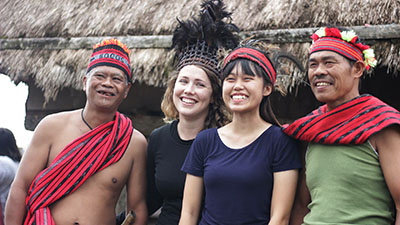 | 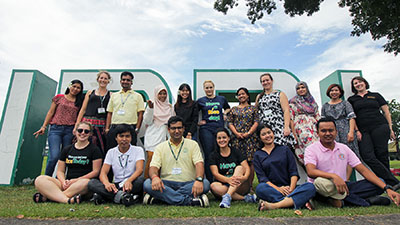 |
Getting a taste for baijiu in China
Visiting breweries in China and sampling the product may sound like good fun but for Functional Grains Centre scientists it’s all part of research to develop markets for Australian sorghum.
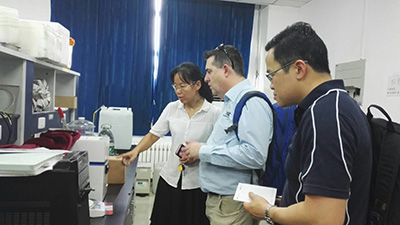 FGC Director Professor Chris Blanchard and postdoctoral researcher Dr Siong Tan spent five days in China during July to build research links and gain new insight into the production of baijiu- a clear spirit usually distilled from fermented sorghum that’s between 40 to 60 per cent alcohol.
FGC Director Professor Chris Blanchard and postdoctoral researcher Dr Siong Tan spent five days in China during July to build research links and gain new insight into the production of baijiu- a clear spirit usually distilled from fermented sorghum that’s between 40 to 60 per cent alcohol.
The FGC research team is evaluating the quality requirements of sorghum for baijiu production and how the grain produced in Australia stacks up.
"We believe there are opportunities to add real export value to the sorghum for Australian producers by understanding the science behind Chinese Baijiu production,” Professor Blanchard said.
During the recent visit to China Professor Blanchard and Dr Tan met with research collaborators at Tianjin University of Science and Technology and the State Key Laboratory of Food Nutrition and Safety.
 “We also visited baijiu breweries to learn more about the fermentation and distillation of the spirit, as well as the quality control measures and marketing of the final product.
“We also visited baijiu breweries to learn more about the fermentation and distillation of the spirit, as well as the quality control measures and marketing of the final product.
“The Jin Jiu Group Baijiu Factory at Tianjin has an onsite museum where they show cast the history of baijiu in general, the products that they have produced previously and the baijiu products currently available in the market.
“We also sampled three types of baijiu, a strong one, a light one and a rose flavour baijiu.
“The Hangzhou Tong Fu Yong Brewery produces baijiu, huangjiu, guojiu, vinegar and soy sauce. It was interesting to tour the fermentation floor and learn about their marketing through an online shop.”
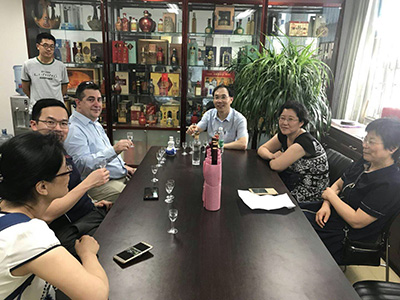 During a visit to the Institute of Agro-Products Processing Science and Technology at the Chinese Academy of Agricultural Sciences in Beijing Dr Tan presented a talk on his studies on high value products from canola meal.
During a visit to the Institute of Agro-Products Processing Science and Technology at the Chinese Academy of Agricultural Sciences in Beijing Dr Tan presented a talk on his studies on high value products from canola meal.
“The tour was an opportunity to cement research collaborations, explore new opportunities for collaboration and gain insight into how to run baijiu fermentation under simulated conditions and a pilot scale study as the next phase of our research in Australia,” Dr Tan said.
FGC engagement
Visitors to the FGC
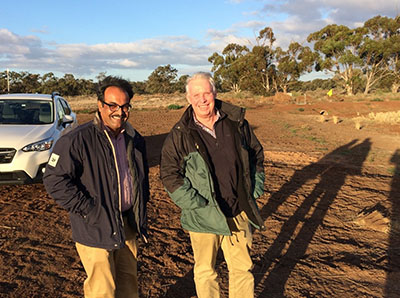 Basmati rice breeder, Dr Gopala Krishnan - from the Indian Agricultural Research Institute, Division of Genetics in New Delhi visited the Functional Grains Centre recently. He has released several basmati rice varieties and made significant contributions to rice breeding in India.
Basmati rice breeder, Dr Gopala Krishnan - from the Indian Agricultural Research Institute, Division of Genetics in New Delhi visited the Functional Grains Centre recently. He has released several basmati rice varieties and made significant contributions to rice breeding in India.
His visit to the rice growing areas of Australia during winter, a time when it looks most unlike a rice growing area in India was a new experience. Although there was not much rice to see, Gopala learnt much from meeting with rice breeder Dr Peter Snell and SunRice research Manager Russell Ford.
The FGC was also pleased to show our research to improve the sustainability and productivity of the grains industry to the participants of the GrainGrowers Innovation Tour in September.
 The tour brought 25 policy professionals from the federal Department of Agriculture and Water Resources, the Department of Foreign Affairs and Trade, the Department of Infrastructure and Regional Development, the National Heavy Vehicle Regulator and the National Farmers’ Federation to Wagga Wagga for the event.
The tour brought 25 policy professionals from the federal Department of Agriculture and Water Resources, the Department of Foreign Affairs and Trade, the Department of Infrastructure and Regional Development, the National Heavy Vehicle Regulator and the National Farmers’ Federation to Wagga Wagga for the event.
FarmLink open day
Functional Grains Centre Director Professor Chris Blanchard and Deputy Director Associate Professor Dan Waters attended the recent FarmLink open day, taking the opportunity to check out new research and engage with grain industry stakeholders.
“FarmLink is a dynamic organisation engaged in a wide array of projects and this was reflected in the number of activities which were taking place on the day,” Professor Waters said.
“It was a wonderful opportunity to meet with farmers, advisors and other stakeholders and learn more about the FarmLink research being conducted.
“I was particularly interested in a trial being undertaken in collaboration with Allied Pinnacle and Aryzta Bakeries.
“The Riverina is the source of the majority of Allied Pinnacle’s wheat which is then converted to flour that Aryzta Bakeries use in their bread.
“Both are very conscious of the importance of wheat quality in determining the quality of their products and this led to the trial that is assessing the impact of nitrogen fertiliser amount, type and timing on bread quality,” Professor Waters said.
New PhD student- Debra Metcalf
Charles Sturt University associate lecturer in psychology Debra Metcalf is no stranger to the Functional Grains Centre but she’s embarked on a new challenge, beginning her PhD study of consumer perceptions, attitudes, and behaviours toward hemp foods.
 I completed a Bachelor of Psychology at Charles Sturt in 2016, graduating with First Class Honours, before commencing work at the FGC on a joint project between GRDC and Charles Sturt titled ‘Expanding options for Australian sorghum’.
I completed a Bachelor of Psychology at Charles Sturt in 2016, graduating with First Class Honours, before commencing work at the FGC on a joint project between GRDC and Charles Sturt titled ‘Expanding options for Australian sorghum’.
This was the market intelligence arm of the project, working with Professor Anthony Saliba. Consumer acceptance of Australian sorghum in China and India was evaluated, and the project was involved in product development for both China and India, as well as locally in Australia.
My PhD topic aligns with the work that I was doing at the FGC but this time the focus is on hemp foods. My research will examine consumer perceptions, attitudes, and behaviours toward hemp foods. This is important as hemp foods were only legalised in Australia in November 2017 and there may be particular stigmas associated with their consumption due to the close association they have with marijuana. Research in this area will ultimately benefit the hemp foods industry.
In search of a winter wonderland
It’s not all field work and laboratory research at the Functional Grains Centre, sometimes you have to take time for an adventure.
PhD Shiwangni Rao explains.
 Growing up in tropical Fiji all I had known were warm temperatures and ample sunshine, except during hurricane season. When I moved to Australia in 2015 I couldn't wait to see the snow, three years later I was still waiting. So this year I was determined those white fluffs of snow on mountain tops would not evade me.
Growing up in tropical Fiji all I had known were warm temperatures and ample sunshine, except during hurricane season. When I moved to Australia in 2015 I couldn't wait to see the snow, three years later I was still waiting. So this year I was determined those white fluffs of snow on mountain tops would not evade me.
Plans were made, and emails were sent, a FGC team building prospect had started but nothing ever goes according to plan and my hopes of seeing snow were dwindling. Luckily the FGC has some very determined, resourceful and adventurous people and that’s how James Lee, Chris Florides and I set out on a team building experience of our own.
The trip lasted two days and a homestead was arranged at Harrietville with a 35 minute drive to the Mt Hotham Snow Resort. As we grew closer to the frosty mountain top I realised that seeing snow can be risky business. The road meanders wildly, white specks of snow in valleys and translucent ice on roads sends cars sliding sideways – this was not the picture of snow I was expecting.
It snowed all day with windy conditions and although we could not see far beyond the front of our car we did arrive at our destination in one piece. I finally got to see real snow and though everything around me was white my first impression was not a winter wonderland, just a ski centre and some lifts.
 The day was still young, and I learnt skiing was not easy as it looked, I’ve even had lessons. While I continued with my epic falls and slides, James perused the greens and blues with his snowboard and Chris skied from colour to colour.
The day was still young, and I learnt skiing was not easy as it looked, I’ve even had lessons. While I continued with my epic falls and slides, James perused the greens and blues with his snowboard and Chris skied from colour to colour.
The next day brought better weather with clear skies, sun and no snow fall. I finally got to see the beauty of winter. The white speck in valleys turned to sheets of glittering white on forest floor. The frosty mountain peaks and ice crystals on posts frozen in their paths. Branches covered in snow and drips of melted ice as the sun warmed up the morning. The sight was as mesmerizing as I had imagined and with clearer skies I could see that what I had mistaken for a single ski centre was actually a buzzing town of snow lovers and adventure enthusiasts. This was my winter wonderland.
We toured all the stations, played on snowed, ate snow and tobogganed the day away. I also managed to improve on my skiing that day and dared a take a run down a green trail named the Big D with James and Chris as my safety guards. Thus, with much encouragement the three of us landed with some smooth skiing, some epic falls and lots of laughter.


